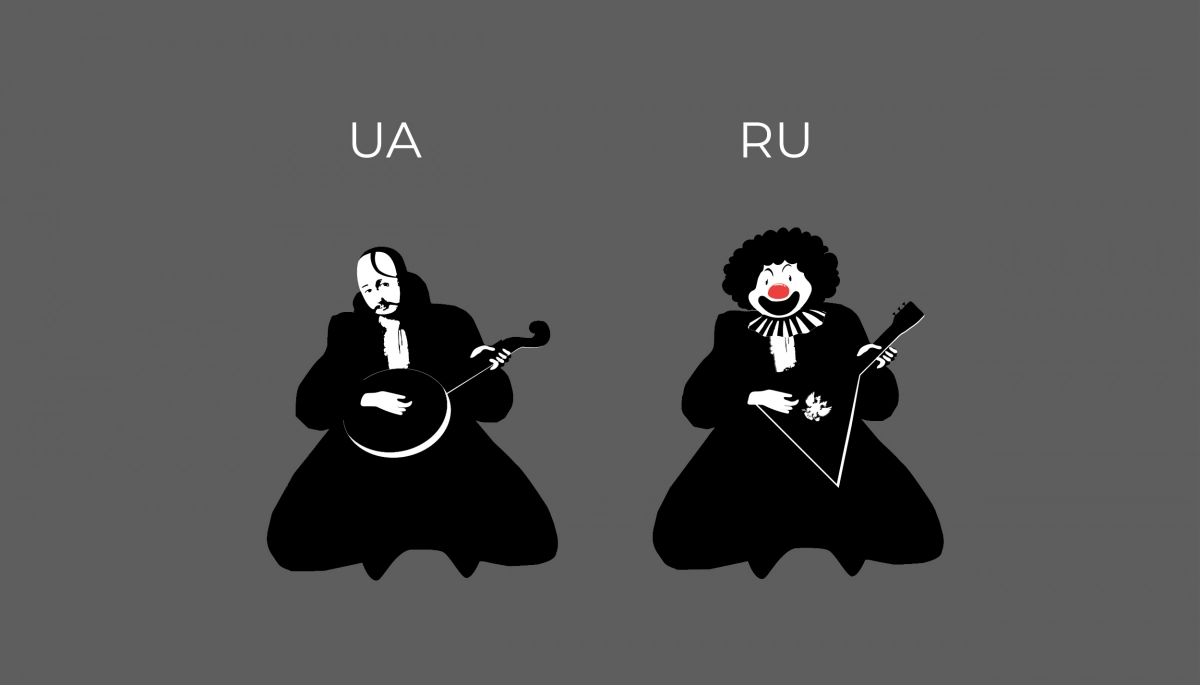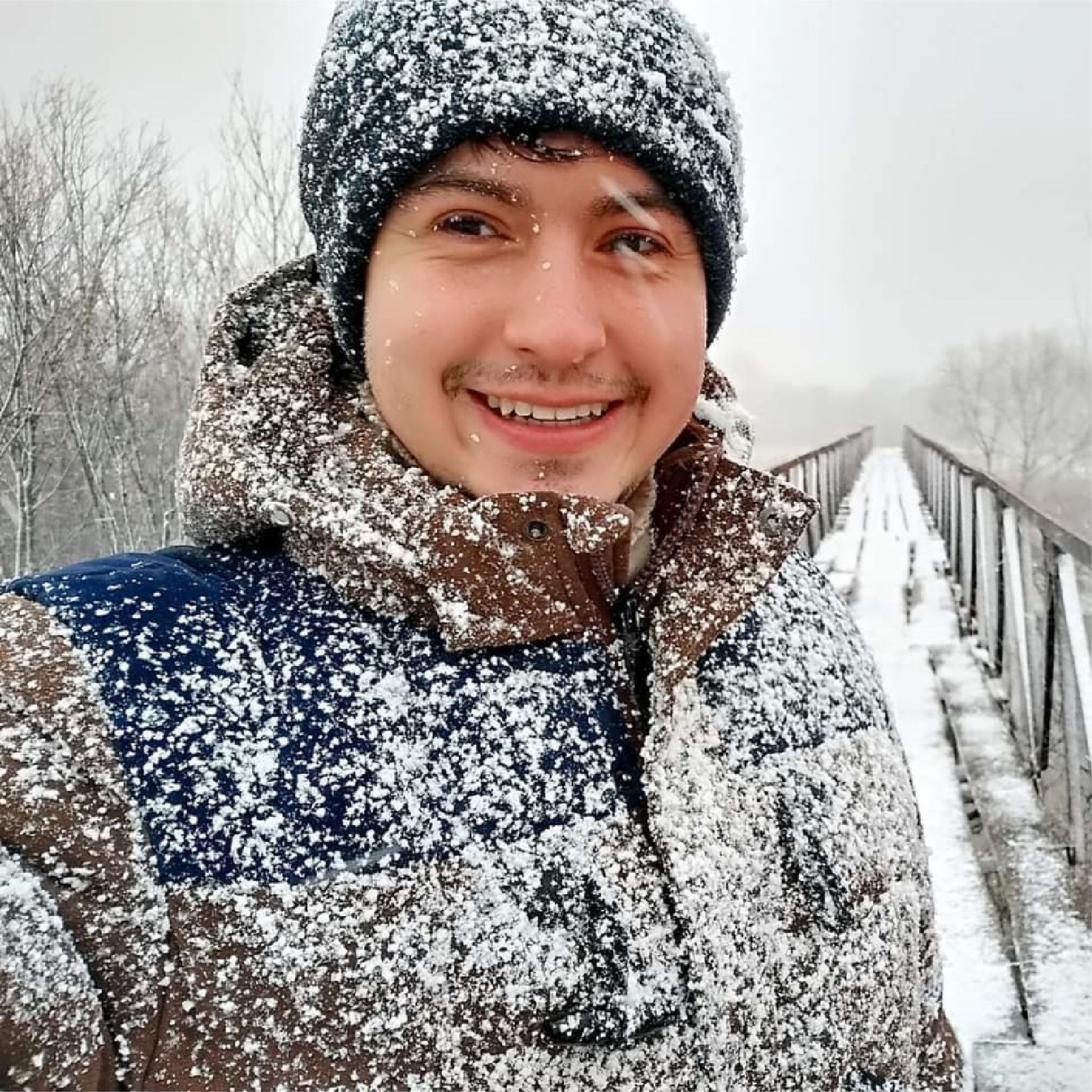
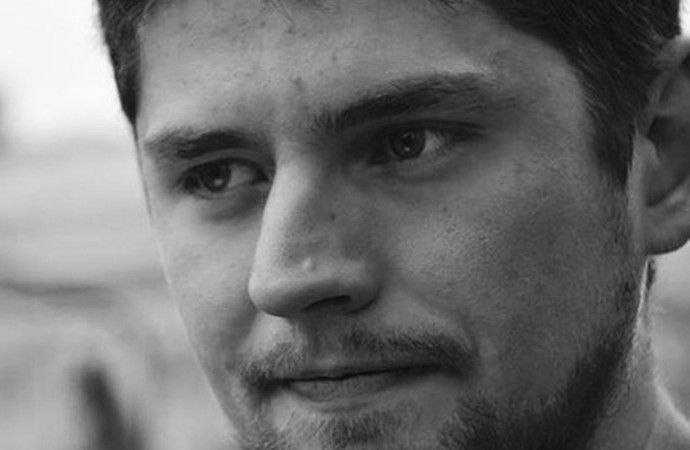
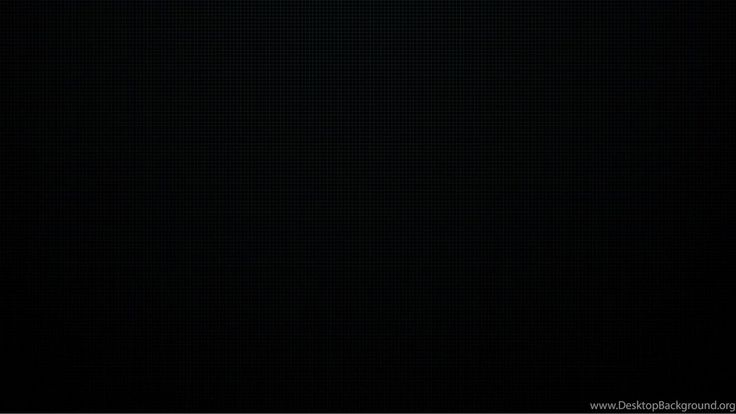
Українською читайте тут.
July 8, 2024, marked the 315th anniversary of the Battle of Poltava in 1709. On this occasion, Detector Media analyzes what today’s independent Ukraine has in common with the Cossack era and how the Russians manipulate the history of the Cossacks and use modern "Cossacks" in the war against Ukraine.
For decades, the Russian Empire and the USSR used the myth of Ukrainian Cossacks’ loyalty to the Moscow tsar to justify their claims to Ukrainian territories and promote the slogans of the "three-united Holy Rus". These claims were reinforced by the celebration of anniversaries, which were given the meaning of symbols of this unity by Russian and Soviet propaganda. Among them is the celebration of the "reunification of Ukraine and Moskovia" in 1954 when the Cossacks tried to enlist the support of the Tsar of Moscow in the fight against the Polish-Lithuanian Commonwealth, and the anniversary of the Battle of Pereyaslav in 1709, when Hetman Ivan Mazepa sided with Sweden.
For propaganda purposes, Russia has reduced each of these events to slogans and myths. For example, the uprising led by Bohdan Khmelnytskyy is being used as a claim of "reunification" with Russia while cutting off aspects of the Cossacks' struggle for recognition as a social group. Mazepa's alliance with the Swedes is reduced to treason for the sake of returning the Polish-Lithuanian Commonwealth to Dnipro’s Left Bank and branding everyone who opposes Russification in Ukraine as "Mazepins" (мазепинці).
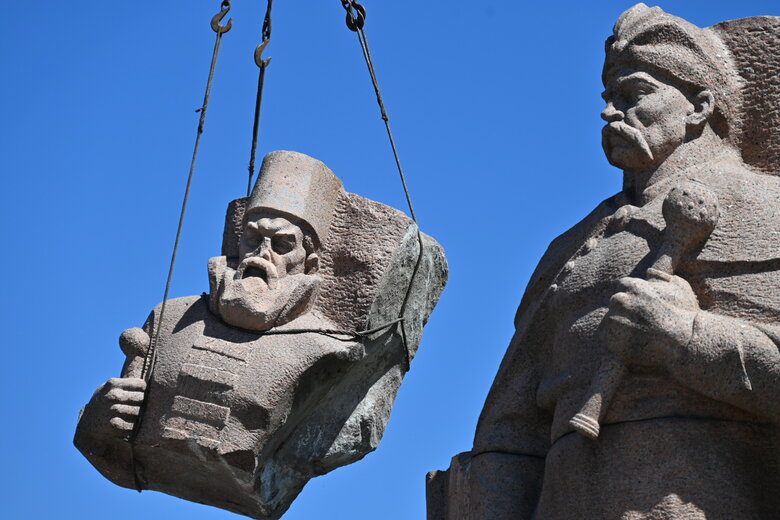
On April 30, 2024, the local council dismantled the architectural composition "Forever Together" in Kyiv in honor of the Pereyaslav Council, which Russian propaganda presents as an act of "reunification of the Russian and Ukrainian peoples", which opened in 1982. The utility vehicle carried a part of the sculpture depicting the Russian ambassador Buturlin, who represented the interests of the Russian tsar. Photo by Oleh Bohachuk
In the interpretation of Russian propagandists, Ukraine cannot claim Cossack heritage, at least because "until the 19th century, there were no Cossacks left as such on the territory of Ukraine." According to Russian pro-government military "expert" Boris Dzherelievsky, due to all the mass relocations that have been going on since the time of Peter I, Ukrainian Cossacks were transferred to the Kuban and Black Sea armies. Based on this, the propagandist concludes that "Ukrainians do not have any legitimate rights to consider themselves descendants of the Cossacks, and it is simply a historical reconstruction."
Instead, Russian propaganda tried to emphasize the loyalty of the Cossacks to Moscow, claiming that the alleged uprisings against the tsar's rule were "extremely rare", the participation of Cossacks in wars against Moscovia was "a fact of ordinary collaborationism", and the Kuban Cossacks "served Orthodox Russia in faith and truth, without thinking about Russophobic intrigues". However, the Cossacks often supported the side that fought against Moscow, and during the collapse of the Russian Empire, the Kuban, and Don Cossacks formed their own state formations that fought against the Bolsheviks and entered into an alliance with the Ukrainian State under Pavlo Skoropadskyy.
"Symbolic Cossacks." Cossacks and Cossack symbols in independent Ukraine
In Ukraine, Cossacks became one of the fundamental myths of Ukrainian identity after the 18th century. Cossacks also appear as an inseparable part of Ukrainian history in modern presentations of it for Ukrainian and foreign audiences. The Revolution of Dignity and the Euromaidan organization of 2013-2014 have also been compared to the Cossack uprisings.
Cossacks are also reflected in the state symbols and ceremonials of Ukraine. For example, the image of a Cossack was on two projects of the Great State Coat of Arms of Ukraine, which won competitions for its development from 1991 to 2020.
During the inauguration, the newly elected President of Ukraine receives from the head of the Constitutional Court the symbol of the Cossack hetmans—a mace, a badge, and a personal seal.
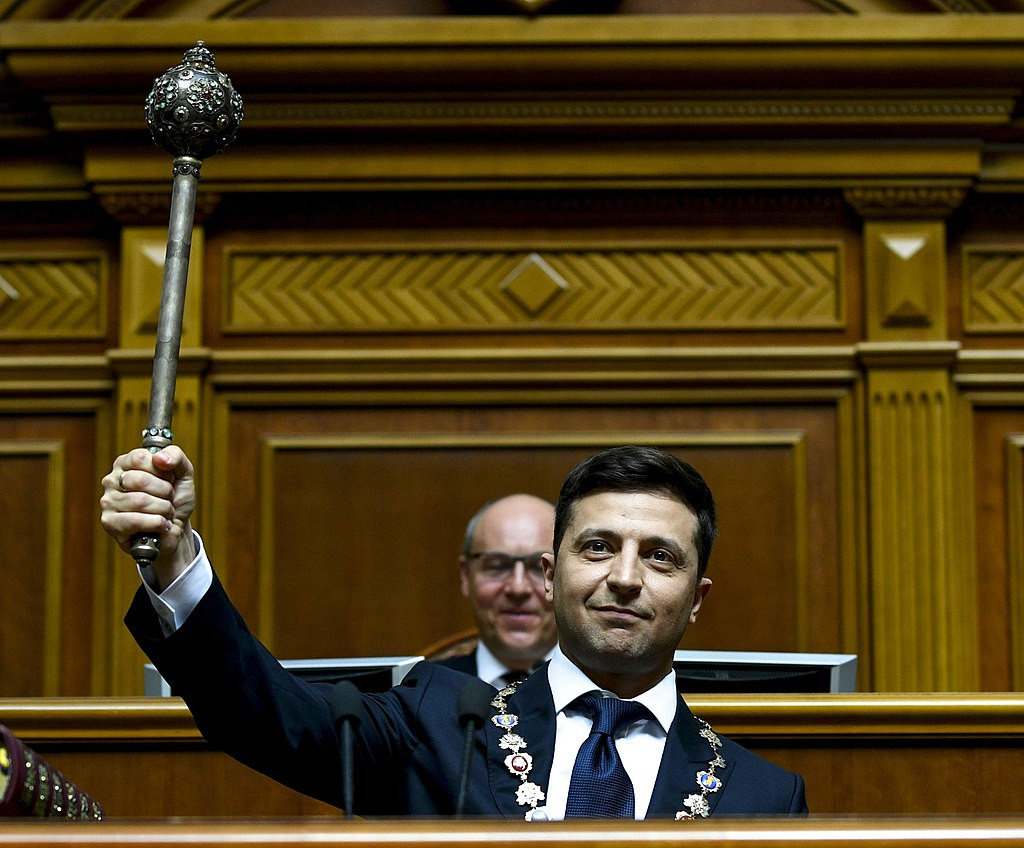
Volodymyr Zelenskyy with the mace during the inauguration on May 20, 2019. Author: Mykhailo Markiv / Office of the President of Ukraine
"We will give our soul and body for our freedom,
And will show that we, brothers, are of the Cossack race," are the lines from the National Anthem of Ukraine.
The Ukrainian military's epaulets contain elements similar to Cossack crosses and maces. The emblems of communities and some state bodies in Ukraine resemble the Cossack cross, particularly the Ministry of Defense, the State Service for Emergency Situations, the Bureau of Economic Security, the Security Service of Ukraine, and the State Intelligence Service.
Apart from symbolic expressions of the persistence of Cossack traditions, the state of Ukraine does not control or lead the phenomenon of Cossacks. At most, it registers and records the termination of organizations' activities with the sequence of letters "Cossack" in their names. According to the registers of public formations and public associations in Ukraine, there are about 3,300 Cossack public organizations. This figure includes only public organizations and formations that are not political parties with "Cossack" names and their branches or organizations founded by community authorities with such names. These numbers may differ from actual ones. After all, due to martial law, the publication of register updates is delayed, or the changes are not made public. The last update of the register of public formations, which we rely on, was published in November 2022, and public associations — in July 2023.
A few Cossack organizations sometimes elect former or current state representatives to leadership positions. For example, on December 28, 2023, a group of activists of the public initiative "Ukrainian Solidarity" together with the NGO "Ukrainian Cossacks" held a vigil on Maidan Nezalezhnosti in Kyiv, canceled the Pereyaslav Agreements and the March Articles of 1654 and elected Valeriy Zaluzhniy, then the Commander-in-Chief of the Armed Forces of Ukraine, as the hetman. Zaluzhnyy himself did not comment on this initiative.
The tradition of declaring politicians as hetmans dates back to 1992. On June 21 of that year, the leader of the People's Movement of Ukraine, Vyacheslav Chornovil, was elected hetman in Pereyaslav-Khmelnytskyy. At the same time, Chornovil also canceled Pereyaslav Rada's decision.
The third President of Ukraine, Viktor Yushchenko, was also hetman. He was elected by the all-Ukrainian public organization "Ukrainian Registered Cossacks" in the first year of his presidency in 2005. It happened on the island of Khortytsia, where one of the Siches of the Zaporozhian Cossacks was located. In 2006, the Donetsk scientist Anatoliy Shevchenko was already called hetman in this organization. He is a hetman in the "Ukrainian Registered Cossacks" to this day. In addition to public activities, "Ukrainian Registered Cossacks" has a stake in two security companies, according to "Opendatabot". In 17 other cases, "Ukrainian Registered Cossacks" were the founders of local branches of the organization.
Such a variety of Cossack organizations serves Russian propaganda. After all, both Ukrainian activists, business people, and politicians, as well as at the same time, supporters of Russia, call themselves "Cossacks".
"State service of the Russian Cossacks". How pro-Russian Cossack organizations in Ukraine helped the Russian occupiers
In Crimea, Donetsk region, and Luhansk region, some "Cossack organizations" promoted the idea of "unity of the Ukrainian and Russian peoples." Subsequently, they covered the Russian occupation of these territories.
Crimea: "Cossacks" against Crimean Tatars
In the first decade of the 21st century, in Crimea, those who prevented Crimean Tatars from returning from deportation from building housing and attacked journalists who covered such conflicts called themselves "Cossacks". The media drew attention to cases when Crimean "Cossacks" took part in raids. For example, the Crimean Tatars were displaced at the behest of entrepreneurs, as happened in March 2004. Then, the "Cossacks" were hired by the deputy of the Verkhovna Rada of Crimea, Mykola Yanaki, the former son-in-law of the ex-speaker of the Verkhovna Rada of Crimea, Leonid Hrach. It is also unknown from whom they guarded the temples of the Moscow Patriarchate.
During protests against NATO exercises in Ukraine in 2006 in Feodosia, Crimean "Cossacks", in particular representatives of the pro-Russian organization "Loyal Cossacks", blocked the routes used to transport weapons from an American warship to a training ground in Old Crimea. The chieftain of the Union of Cossacks of Feodosia told Russian publications about his intention to continue the blockade despite the decision of the Verkhovna Rada, confirming the readiness of "thousands of Cossacks" to oppose a possible breakthrough by the security forces. To justify the protesters' actions, the Russian media spread fake news about poisonous and explosive substances located on the American ship.
In 2014, some of these "Cossacks" covered the Russian occupation of Crimea. In particular, they prevented the work of journalists and those who resisted the occupation. A journalist from Kerch, Viktoria Yermolaeva, recalls that Cossacks in the city threatened journalists. After the dispersal of pro-Ukrainian actions, they disappeared from the city. As journalist Ian Birrell from The Independent reported in March 2014, the Russian military pretended to be the Cossacks.
After the annexation of Crimea, local "Cossacks" re-registered under Russian legislation. In October 2015, the occupying "head of Crimea," Sergey Aksyonov, signed a "decree" approving the charter of the Cossack Society of the Crimean District. According to the Russian law "On the Civil Service of the Russian Cossacks" of 2005, the activities of Cossack organizations are controlled by the state. In Russia, the President of Russia determines a list of Cossack organizations, their form, and symbolism. This hierarchy's activities aim to organize Cossacks for service in the "Cossack units" of the Russian Army and the Russian Guard. In addition to military functions, Cossacks in Russia have law enforcement functions in their communities and organize conscripts’ military and patriotic education.
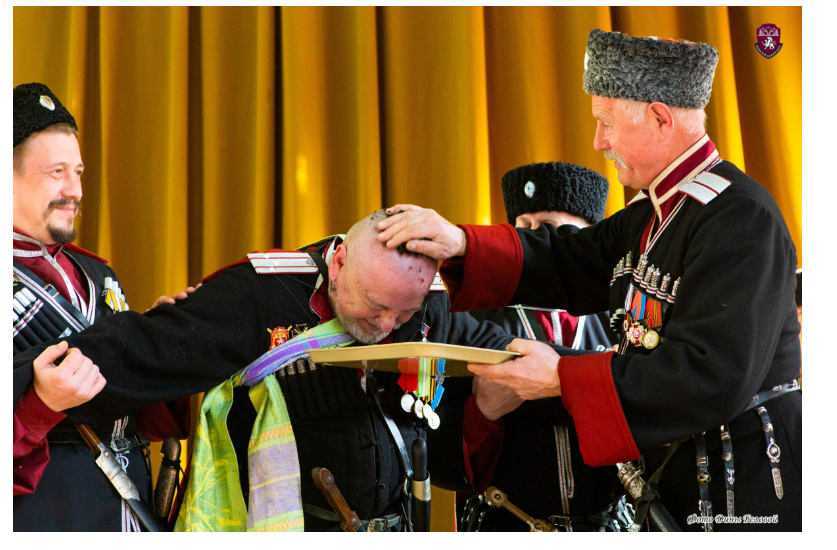
Crimean Cossacks anoint the head of the newly elected "atan of the Crimean District Cossack Society," Vadym Ilovchenko, with soil. February 19, 2022. Photo credits: the Crimean District Cossack Society in VK
According to the human rights organization "CrimeaSOS", in November-December 2015, "Crimean Cossacks" took part in raids on homes of Crimean Tatars to "fight extremism" and to "maintain order".
In the occupied territories of Ukraine, the Russian "military-patriotic education of conscripts" is a tool of control over local youth to provide the Russian army with military service members, in addition to the "Conscript Days" and the "Young army" organization brought from Russia. The "Crimean District Cossack Society" is also involved in the "patriotic education of youth" activities, as reported in 2019 by the Crimean Human Rights Group.
"The actions of the "military commissariats", educational institutions, and paramilitary formations violate the norms of international humanitarian law, which prohibit the promotion of service in the army and the conscription of residents of the occupied territory into the occupier's army. In addition, the promotion of conscription into the army among minor children also violates Article 1. 38 of the Convention on the Rights of the Child," reported the Crimean Human Rights Group.
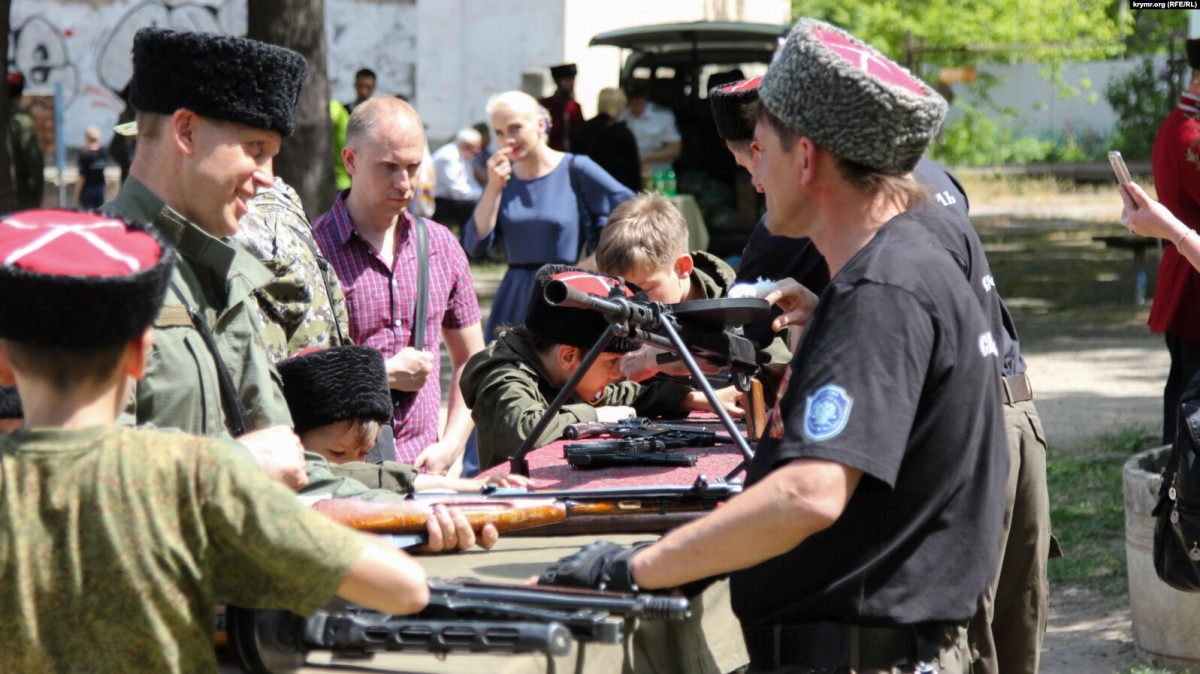
Consecration to the Cossacks. Possibly Kerch. 2019. Photo credits: Krym.Realii
As Krym.Realii reported in September 2023 that the "Crimean Cossacks" also helped the Russians carry out "partial mobilization" of the Russian army in the "Cossack" Tavrida assault battalions. Krym.Realii calls them "secret members of Aksyonov's PMC". The publication, referring to the report of the chief of the Crimean "Black Sea Cossack Army" Anton Sirotkin, mentioned that in April 2023, two Crimean Cossack battalions participated in the war against Ukraine. The Black Sea Cossack Army also has a youth wing. The development of the second one is the second priority for the "chieftain" Sirotkin:
"Because I see how we need new Cossack blood and new chieftains — alive, energetic, competent, well aware of the legislation and the complex system of state administration, that is, they will be able to bring to life all the Cossack potential at different levels. This is very important, and that is why Cossack education, Cossack youth, and culture are what we hold as a second priority after the special military operation [the first priority]," said Sirotkin in an interview with the "Russian Cossacks" portal.
As of the beginning of July 2024, the website of this "troop" contains information about only one "Tavrida" battalion as part of the "Rosgvardiya". In December 2023, battalion members shouted "Love! Love! Love!" supporting Putin becoming the President of Russia for the sixth time.
Luhansk Region: "The Don Cossacks of Luhansk Region do not want to live in a foreign state that separates them from Russia"
Stanytsia-Luhanska was one of the region's main centers of "Cossack" activity. Local "Cossacks" published the regional newspaper "Cossack Frontier". In 1993, they published an article in which they wrote: "'independents' [supporters of independent Ukraine] must respect the feelings of the people of Sevastopol, the Crimeans, the Don Cossacks of the Luhansk region, who do not want to live in a foreign state that separates them from Russia by its borders and customs."
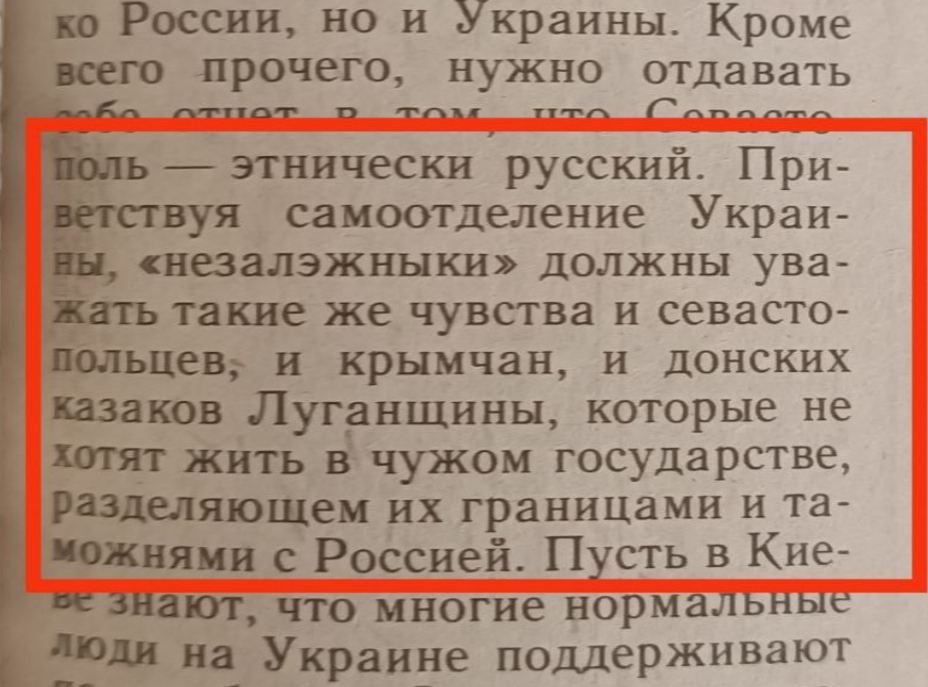
Part of the article in which Luhansk Cossacks recite their anti-Ukrainian position. "Cossack Frontier", No. 5, 1993
The "Don Cossacks" of the Luhansk region brought up the issue of dual citizenship in public discourse, the introduction of the Russian language as the official language, supported the "St. George's Ribbon" rallies, called for the "reunification of Russia, Belarus and Ukraine" and protected Orthodox churches from "capture by the Philaretites". Pro-Russian politicians from the Party of Regions of Ukraine used the "political activism of the Cossacks" to deepen differences with the Ukrainian government or to put pressure on the authorities and demand the introduction of regional bilingualism.
The local authorities of Luhansk were also involved in the authority over the local "Cossacks". For example, they promoted Pavel Orlov to the position of "chieftain" of the "Luhansk District of the Don Cossacks" in 2009, which was unpopular among the local "Cossacks". His candidacy was chosen based on the recommendation of Viktor Vodolatsky, the leader of the Russian paramilitary organization "The Great Don Army", a "Russian Cossack," and a member of the State Duma of Russia. Vodolatsky repeatedly complained about the unfairness of the borders between Ukraine and Russia:
"Luhansk and Donetsk oblasts are also the territory of the All-Great Don Army. They are now glued to Ukraine, just like Crimea, which someone handed over to Ukraine for an unknown reason. Luhansk and Donetsk regions are our lands; our Cossacks live and work there."
In 2004, Vodolatsky demonstrated his dubious knowledge of history and geography by stating that he was a "Russian Cossack." In 2023, in an interview with the "Southern Gate" propaganda project, Vodolatsky said that the land of Luhansk "has been covered with the blood of the Don Cossacks for thousands of years."
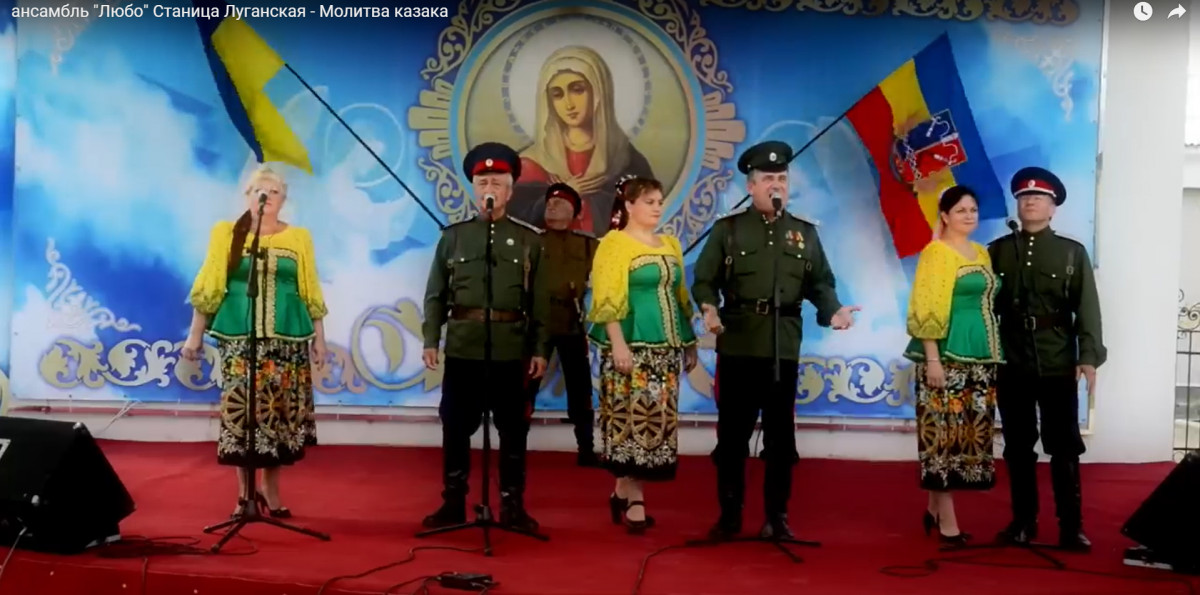
From the ensemble’s "Lyubo" music video for the "Cossack’s Prayer" song
Luhansk region’s "Don Cossacks" were invited to regional events and holidays, where they sang about the "Russian world". For example, in the "Cossack’s Prayer" song performed by the ensemble "Lyubo", they sang about "the Motherland, our holy Russia, our only faith, Slavs, dear to my heart, may our Orthodox state live for centuries." From this part of the text, it becomes clear that the "Don Cossacks" believe in the idea of a "three-united Russia", and Orthodoxy, which is mentioned in the song, can only be in the form of the Moscow Patriarchate.
The concentration of propagandistic songs occurred at Cossack festivals, particularly at the annual "Lyubo" festival, which even "Russian Cossacks" attended.
"Don Cossacks", although being citizens of Ukraine, ignored Ukrainian Cossack organizations. They swore allegiance to "Don and Russia" and joined Russian associations, for example, the already mentioned Military Cossack Society "All-Great Don Army" or the competing International Union of Public Associations "All-Great Don Army", headed by Nikolay Kozitsyn — a resident of the Rostov region, who believed in the idea of creating an independent Cossack state, for which he was deprived of all his Cossack titles and did not have access to positions in state Cossack organizations. Instead, Vodolatsky's Cossack association was completely under the control of the Kremlin: according to the organization's charter, a candidate for the post of Supreme Chieftain must necessarily be approved by the Russian President's Council on Cossack Affairs.
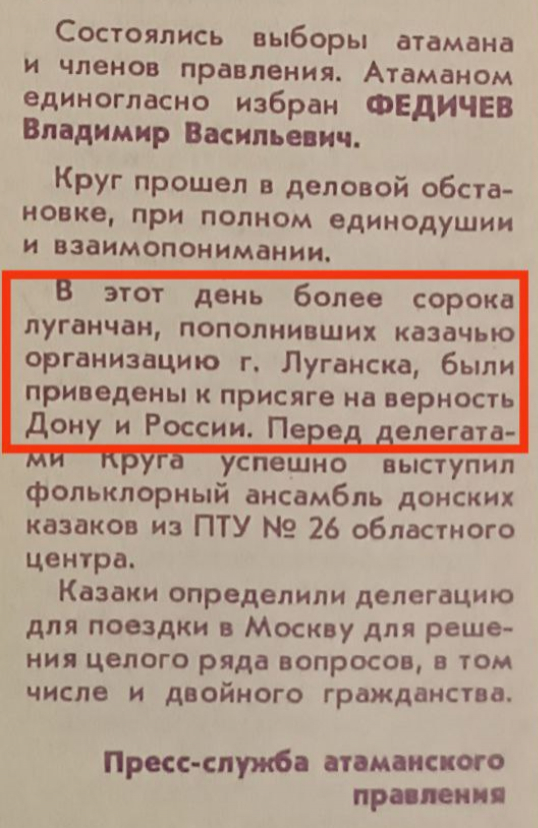
An article in the newspaper mentions the Luhansk "Cossacks" swearing allegiance to Russia. "Cossack Frontier, No. 1, January 1993.
In 2014, representatives of the Luhansk district of the All-Great Don Army called on Putin to send troops into Ukraine: "We appeal to you not to abandon us to the mercy of Western herods. And in the event of further deepening of the political crisis and attempts to deploy NATO troops on Ukrainian territory — provide military support to the Ukrainian people."
The Luhansk Don Cossacks were also linked to the Kremlin through religion. Since 2009, the Cossacks have been under the patronage of the Russian Orthodox Church, which was implemented after the enthronement of Patriarch Kirill Gundyaev. He was proclaimed the highest spiritual leader of the Cossacks. Such church patronage extended not only to Russian Cossacks but also to Ukrainian Cossacks. For this purpose, the Synodal Department of the Ukrainian Orthodox Church of the Russian Orthodox Church was created in Ukraine on Cossacks’ pastoral care issues. The Coordinating Council of Atamans, headed by a collaborator, Alexey Selivanov, operated under this department.
The Don Cossacks of the Luhansk region also conducted military training for their members and organized the reconstruction of historical battles to consolidate practical fighting skills. By combining combat experience and indoctrination with the ideas of the "Russian world," the Kremlin obtained motivated and experienced fighters suitable for hybrid aggression.
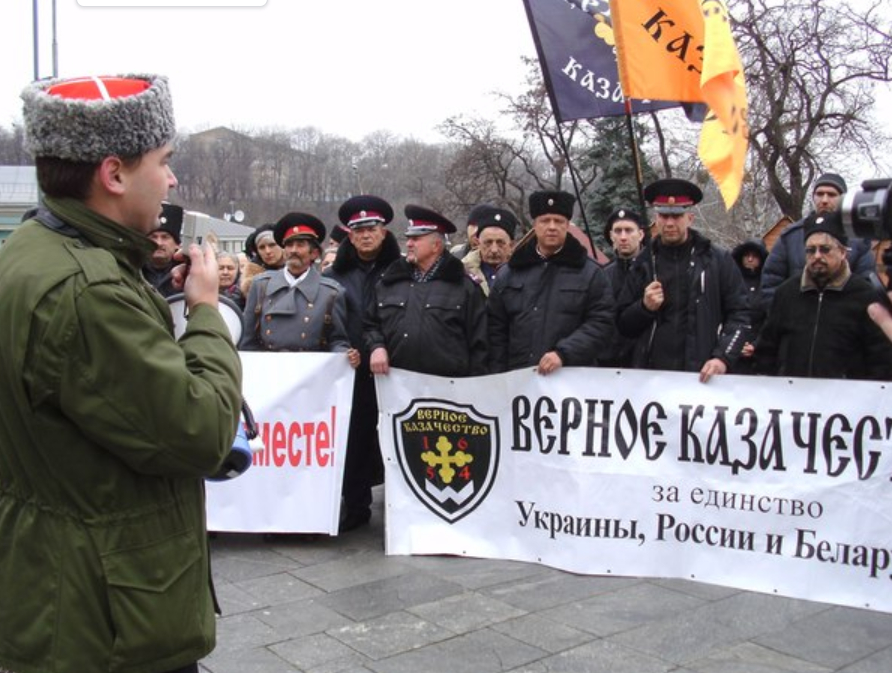
Representatives of the pro-Russian "Loyal Cossacks", led by Selivanov, at rallies in support of Yanukovych in 2014. Photo from Russian propaganda publications.
At the beginning of 2014, the Luhansk "Don Cossacks" were part of the "people's battalions" formed by the regional administration to "protect" the Luhansk region "from provocateurs". With the beginning of hostilities in the East of Ukraine, the "Russian Don Cossacks" also became active. In April 2014, the head of the Russian International Union, "The Great Army of the Don," Nikolay Kozitsyn, issued an order to form the "Cossack National Guard in Ukraine", after which his Cossack troops were transported to the Luhansk region.
Kozitsyn's plans differed from the "Novorossiya project", and therefore, at the end of 2014, a struggle for power in the region between the Cossacks and the occupational administration of the occupied territories of Luhansk region under the command of Igor Plotnytsky began. Nikolay Kozitsyn would create the "Don Cossack State" "from Volgograd to Donetsk and Luhansk". At the end of 2014, "Cossack" formations controlled almost 80% of all occupied territories of the Luhansk region. At the beginning of 2015, alternative formations under the control of local Cossack authorities were proclaimed in large cities of the occupied Luhansk region. On the territory of Sverdlovsk, Rovenkiv, and Antracit, they declared the "Cossacks People’s Republic" led by Kozitsyn’s Cossacks. In the meantime, the local "chieftain" Pavel Dryomov seized power in Stakhanov and Pervomaysk. Although the "Cossack" rebellion was suppressed, the Don "Cossacks" contributed to [Russia’s] occupation of the Luhansk region.
According to information from the website of the All-Russian Cossack Society, as of the end of 2022, about 15 thousand Cossacks took part in the war against Ukraine. The Russian news agency TASS reported on about 28 thousand Cossacks. Despite such different assessments, it can be argued that long before the start of its aggression, Russia was building a network of controlled "Cossack" organizations in the Luhansk region, indoctrinating the local population with the ideas of the "Russian world" due to which Russian agitational propaganda could present the war in eastern Ukraine as an exclusively internal Ukrainian conflict and "civil" war.
Donetsk region: "And Girkin is a Cossack"
In the Donetsk region, the activities of pro-Russian and Russian "Cossack" associations in 2014 were barely noticeable. In the occupied territory of the Donetsk region, the "Cossacks" have barely created their armed units. The exceptions, which rather confirm the rule, are the detachments of "chieftain" Kozitsyn, who, in addition to the Luhansk region, briefly occupied the territory of Debaltseve. For example, the so-called "Tersk Wolf Hundred", which, under the leadership of Igor Girkin, took part in the occupation of Crimea, and then Sloviansk and Kramatorsk. Russians commanded the "Terska Hundred" detachment, and as per the available data, it mainly consisted of Russian citizens. Although the locals also joined it.
Before the start of the war, during Euromaidan, local "Cossack" organizations announced their participation in patrolling and "maintaining law and order" in Donetsk and other large cities of the region. On February 3, 2014, the "Donbas" TV channel published a report on a joint rally of veterans of the war in Afghanistan and "Cossacks", which was held under the slogans "for the peace and unity of Ukraine."
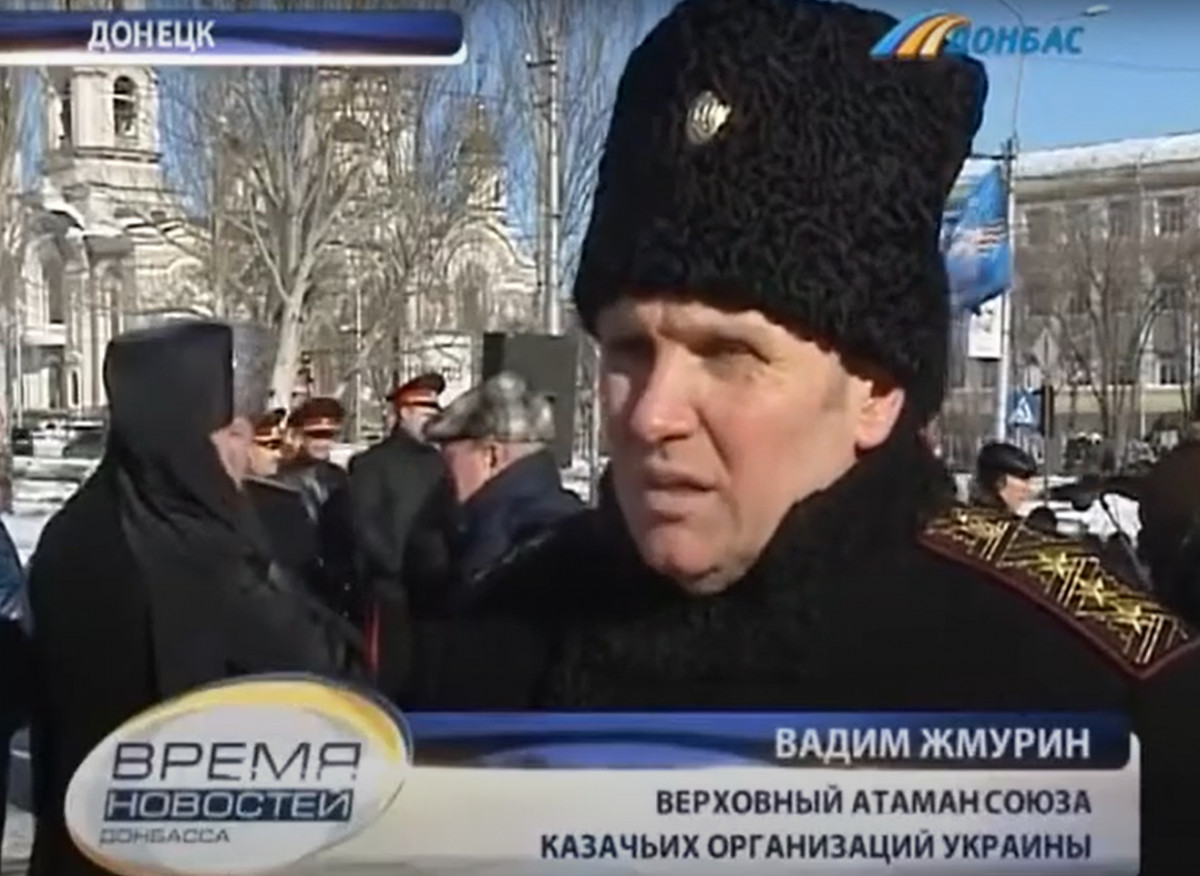
Vadim Zhmurin from the story of "Novosti Donbassa" on February 3, 2014
One of the rally participants, "Supreme Chief of the Union of Cossack Organizations of Ukraine," Vadim Zhmurin, stated that 1,500-2,000 "Cossacks" are participating in patrolling the streets. In December 2022, the same Vadim Zhmurin, as "supreme chieftain of the United Cossacks of Donbas," discussed the activities of the "Cossacks" in the occupied territories, as well as the plans to join the Russian "Great Army of the Don", and "working with youth". According to him, the "Cossack Orthodox discipline" was introduced in some occupied schools and universities, which now study the "history, ethics and ideology of the Cossacks".
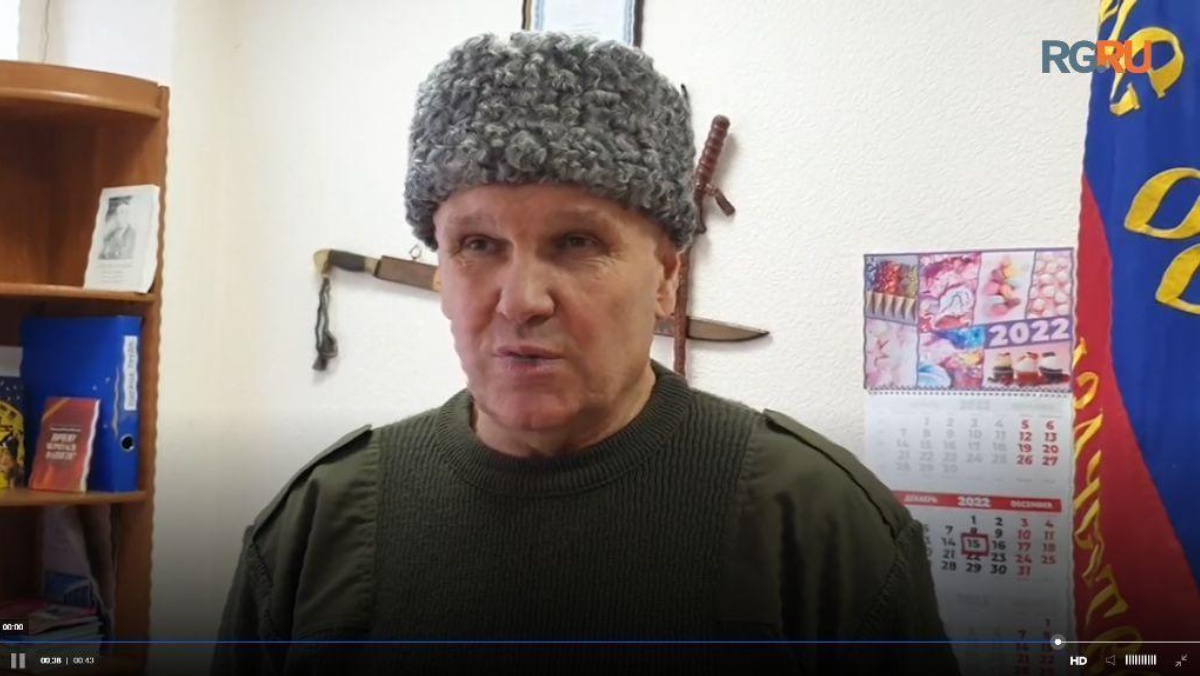
Vadim Zhmurin discussed the Donetsk "Cossacks" joining the Russian "All-Great Don Army" in December 2022. Source: "Volgodonskaya Pravda"
According to YouControl data, the Production Experimental Firm 'Akva-Vita' was owned by Donetsk businessmen Oleg Taruta and Oleg Mkrtchan, co-owners of the corporation Industrial Union of Donbas. In 2014, Taruta was the head of the Donetsk regional administration. Since 2019, Taruta has been a People's Deputy of Ukraine.
Despite their modest role in hostilities before and after the full-scale invasion, local "Cossack" organizations try to imitate activeness in the occupied territories of the Donetsk region. In October 2022, after the liberation of Lyman, they announced the creation of the "Krasnolyman Cossack Regiment" in occupied Vuhlehirsk with the aim of returning Lyman. Valeriy Tkachenko has been appointed as the chieftain of the new "regiment." Tkachenko previously was the head of the occupational administration of Shchurove, a former resort village near Lyman. The creation of the "regiment" was announced by Sergey Bumagin, the organizer of the separatist checkpoint in Vuhlehirsk in 2014, who later "rose" to "Cossack colonel, chieftain of the district named after Kindrat Bulavin." A year later, in September 2023, Bumagin named the number of members of the "Union of Cossacks of the Donetsk People’s Republic", which included his "district" — 200 adults and about 100 children. Among the main tasks of the Cossack collaborators, Bumagin and Zhmurin declared "work with youth."
In addition to the "Krasnolymansk regiment", data on the work that had not appeared since 2022, the Russian "Cossacks" also announced the creation of other "Donetsk" units. In particular, in December 2023, the "Donetsk Cossack Volunteer Battalion" organization was announced, now part of the "Terek" brigade. In November 2023, the Cossack volunteer battalion "Karachun" had been created. It is unknown whether these battalions were actually created; at least, there is no data on their participation in hostilities, just like in the case of the "Krasnolymansk Regiment".
Yet, the occupiers seem to be missing enough existing (or fictitious) organizations. In February 2024, at a meeting of the head of the occupation administration of the Donetsk region, Denis Pushylin, with the "chieftain" of the "All-Russian Cossack Army" Vitaliy Kuznetsov, discussed the creation of the "Registered Cossacks" in the territories controlled by Russia. These "Cossacks" should already be subject to Russian organizations and Russian laws that regulate the activities of "Cossack communities". However, it remains unknown where the occupiers will find a sufficient number of members for the new organizations if the old proclaimed "districts", "regiments", and "battalions" are active mainly on paper. Perhaps the "Cossacks’s" work with young people is aimed precisely at solving it.
Conclusions
Starting from the 18th century, Russia transformed the Cossacks into an instrument for conquering new territories by incorporating them into the empire's army. By the end of their existence in the Russian Empire, the Cossacks became one of the main supports of the tsarist regime and a symbol of repression against peasant uprisings and worker disturbances. The myths about the 'loyalty' of the Cossacks to Russia replaced the complexities of history and 'resolved' questions about the ethnic affiliation of the Cossacks. After the collapse of the Soviet Union, for some people who did not accept it, 'Cossackhood' became a form of expressing nostalgia for the past. They easily fit into Russian 'Cossack' movements, which, after the adoption of the Russian law 'On the State Service of the Russian Cossacks' in 2005, became part of the state machinery of Russia. This led to the integration of 'Cossack' structures into the power ministries of this state. They also work as tools for attracting youth to the Russian army. Overall, in modern Russia, official 'Cossack' organizations strive to achieve the same role as in the Russian Empire, advocating loyalty to the 'tsar-president' and dispersing opposition rallies.
Ukrainian dissidents and representatives of the state accepted the ideas of the Cossacks. They used this phenomenon as one of the common denominators to build a new state. However, as evidenced by the cancellation of the Pereyaslav Agreements by Vyacheslav Chornovil, Russian myths about Cossacks were superimposed on the perception of Cossacks. These myths remain relevant even today. After all, one of the thousands of Cossack organizations of Ukraine on Independence Square in Kyiv canceled these agreements in December 2023.
Some Ukrainian Cossack organizations work as a means of influence or an auxiliary tool for increasing recognition through the use of the image of Cossacks or the declaration of famous persons as "hetmans." The impact of using such individuals or attaching the image of Cossacks to business tends to discredit Cossack organizations in general.
With such a variety of types of Cossacks, the independent Ukrainian state chose to use the symbolic signs of Cossacks without its leadership. In this form of organization, in contrast to Russia, where the Cossacks are part of the army or the Russian Guard, force and police functions are performed by non-bearers of political, subcultural, or ethnic views. After all, in Russia, for example, the Russian Guard includes people with different values—for example, the ostensibly Orthodox "Cossacks" and the Muslim fundamentalists- supporters of Kadyrov.
Long before the start of the war in eastern Ukraine, Russia tried to use Cossack organizations to promote its influence in Ukraine. This happened both with the help of Ukrainian organizations and their connections with Russian "brothers" and the Russian Orthodox Church, as well as through the efforts of Russian organizations to enter the territory of Ukraine and recruit their members directly, especially in the territory of the Luhansk region. In 2014, the Cossacks played a part in the beginning of the hybrid war. The Russian troops of "chieftain" Kozitsyn occupied several cities, mainly in the Luhansk region, and for some time even tried to conduct their own policies there and compete with the occupation authorities. However, very quickly, the "Cossacks" in the occupied territories were taken under Russian control, and their leaders either fled back to Russia or were killed, like the Kadiyev "chieftain" Pavel Dryomov.

